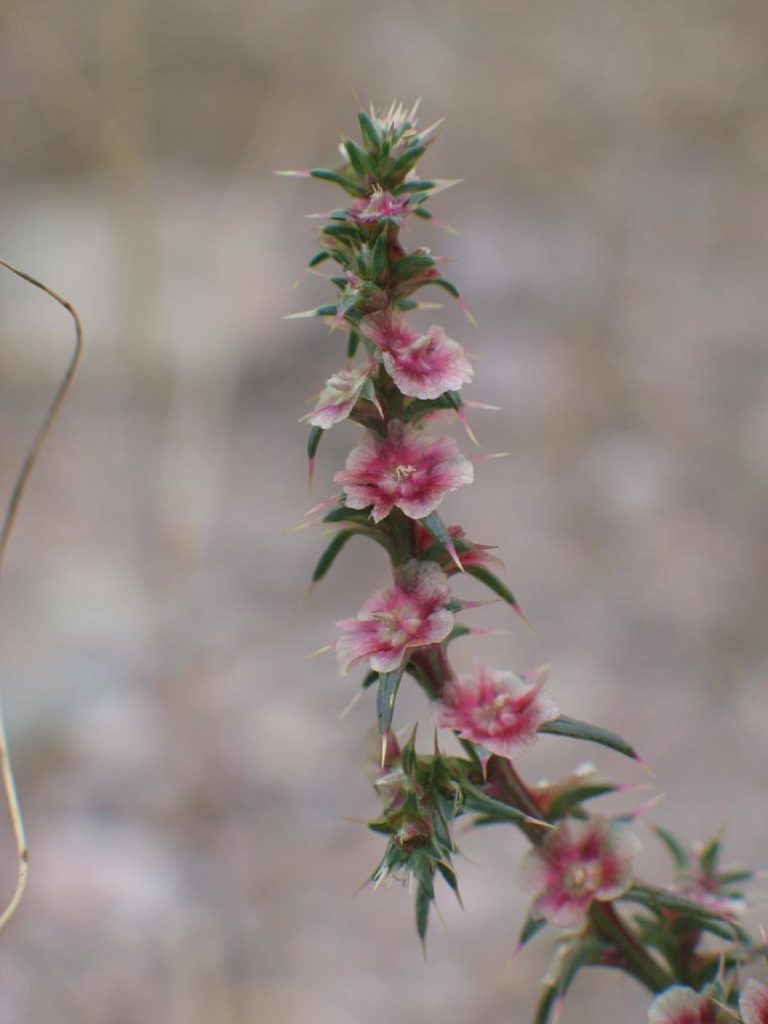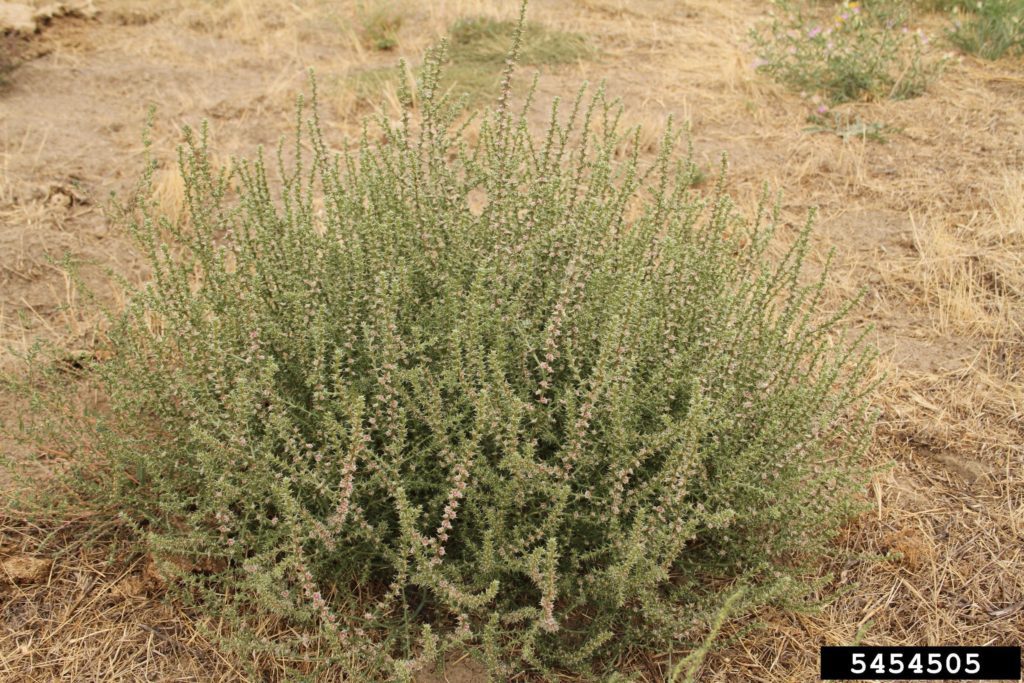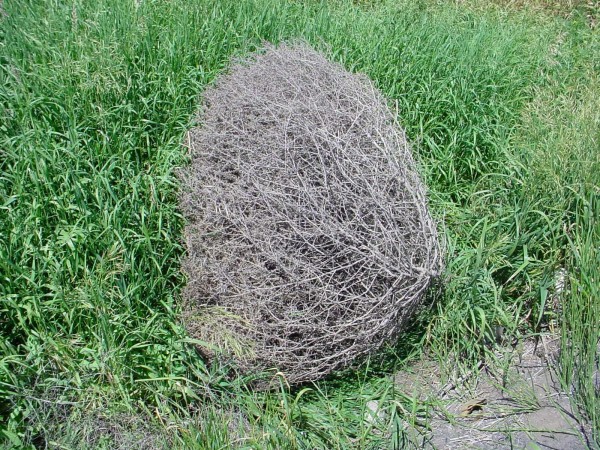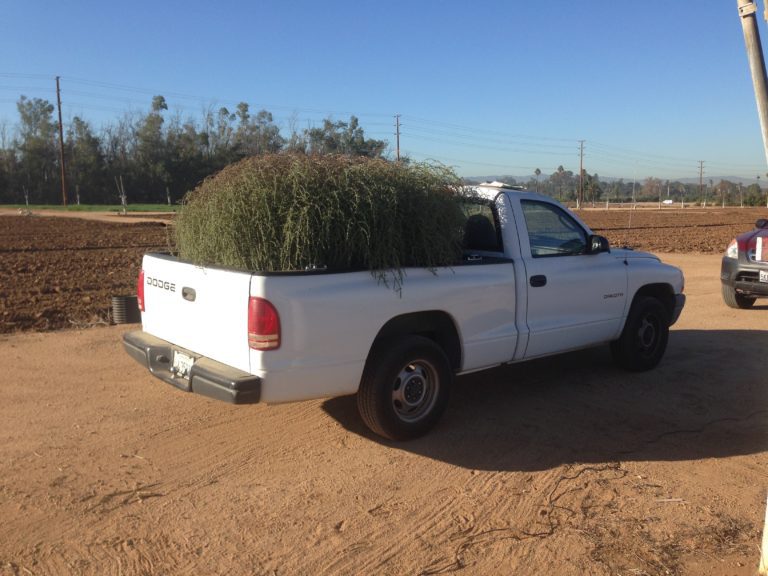Tumbleweeds
The noble tumbleweed. Iconic western movie prop, spikey nuisance, and incredible survivor. There are many different kinds of tumbleweeds but each one disperses seeds by snapping off a piece of itself and letting it tumble away in the wind.
Tumbling Away
Tumbleweeds are very unique plants. When it comes time for flowering, the entire bush-like shape of the plant will fill with small flowers. Some tumbleweeds are so beautiful when flowering that they are actually used in gardens (we advise against this, for reasons explained later).
After pollination of these lovely little flowers, seeds are produced. While the plant is still green it is actually often used as forage by deer, antelope, small mammals like prairie dogs, and even domestic sheep, goats, and cattle. As the plant matures it becomes very stiff and many species have sharp spines on its leaves. At this point very few animals can or will eat it and the plant will then develop seeds. Instead of relying on animals or the wind to spread its seeds, the tumbleweed takes matters into its own… leaves and simple snaps off its seed–head in order to go for a romp.
The tumbleweed plant itself is perennial (coming back again each year) but the aboveground leaves and twigs that make up the seed-head are willingly sacrificed in order to have the best chance at seed dispersal.



Masters of Seed Dispersal
Tumbleweeds are made for tumbling. Their round shape lets them roll, and a good push of wind will send them bouncing on branches that are stiff yet flexible and act as a spring. All this moving across the landscape makes tumbleweeds great a spreading their seeds far and wide.
Dirk V. Baker from Colorado State University looked at diffuse knapweed (a species of tumbleweed) to try and figure out just how far they could spread their seeds. He found diffuse knapweed can still keep seeds even after tumbling over a mile (1800 meters). A lab experiment where he and his team put tumbleweeds in a wind tunnel found suggested that these plants have a linear model of seed dispersal. This means that they (more or less) drop off seeds at a steady rate. This is very different from other plants which tend to drop seeds mostly near the mother plant, with a few seeds making it further away. Wherever the tumbleweed tumbles, seeds are sure to follow.
A study by George P. Stallings looked at another species of tumbleweed: the Russian thistle. They found that this much larger tumbleweed could travel large distances and even hop fences and farm equipment. One plant traveled over 2.5 miles (4069 meters) in only six weeks.
Species of Tumbleweed
The method of tumbling a part of their body in order to spread seeds is surprisingly common in the plant world. You can find tumbleweeds in the following plant families: amaranths, sunflower, cabbage, forget-me-not, carnation, bean, sage, and grass families (among others). Usually however, when someone mentions a “tumbleweed”, they are picturing the more iconic Old West style tumbleweed which is quite large. Let’s explore some of the unique species of tumbleweed that exist.
Dinosaur Plant
A tumbleweed of many names, the dinosaur plant (aka: Rose of Jericho, resurrection plant, resurrection moss, or stone flower) can survive nearly completely drying out by curling up tightly and waiting for rain even if it takes years. This amazing survival ability makes them the subject of many pieces of folklore.
Dinosaur Plant
A tumbleweed of many names, the dinosaur plant (aka: Rose of Jericho, resurrection plant, resurrection moss, or stone flower) can survive nearly completely drying out by curling up tightly and waiting for rain even if it takes years. This amazing survival ability makes them the subject of many pieces of folklore.
King of the Tumbleweeds
There are big tumbleweeds, and then there’s the Russian thistle (Salsola tragus). This plant is extremely widespread and can be found in North and South America, Europe, Asia, and even Australia. There is some debate on whether the Salsola species in Australia is actually a separate, native species but that is still an impressive range. Originally from the Eurasian Steppe, this plant has amazing adaptations to help it survive the toughest of climates. Russian thistle is so good at what it does that it is actually considered a pesky weed outside its native range. There are regions that classify this plant as a noxious weed which require the landowner by law to take measures to eradicate its presence.
As if having one Russian thistle wasn’t bad enough, this plant also has hybridized across its range, leading to even larger and more pesky plants. Many Salsola species exist, and each is giant. This plant is so wide-spread and varies so much from habitat to habitat that it is unclear just how many species exist. It also has many different common names and even the scientific name is not agreed upon.

Even the seeds of Russian thistle are unique, with very little moisture needed for the dropped seed to sprout. In fact, they can germinate with as little as 0.1 inches (0.25 mm) of rain, and if conditions are right can begin sprouting within minutes of contact with the soil. A giant tumbleweed also produces many, many seeds with estimates ranging from 150,000-250,000 seeds per plant.
Tumbleweed Panic
All around the world, swarms of tumbleweeds can be found trapping people inside their homes, closing down highways, and just generally causing havoc. Removing the plants is harder than it seems as the tumbleweeds are sharp and some species can even cause skin irritation when handled. These plants are great at what they do, and as such can cause issues as they spread across the grasslands of our world.
When coming into contact with crop fields, it has been found that Salsola species of tumbleweeds can severely reduce crop yields as well as spread diseases to the crops. Tilling fields after harvest has been found to be effective at reducing tumbleweeds as well as planting a cover crop such as winter wheat. Tilling fields should only be used in extreme cases however, as it can lead to many other issues such as erosion and decreased soil quality. Russian thistle is also becoming resistant to many herbicides.
In the Southern California's high desert, people are calling 911 for help because of an invasion of tumbleweeds. Read the story: https://t.co/LafXGcRPoz pic.twitter.com/X1KSj0VYdn
— AP West Region (@APWestRegion) April 18, 2018
Controlling Tumbleweeds
Don’t:
- Use fire: tumbleweeds love disturbed environments and will spread quickly in areas that have recently seen fire
- Mow: not only does this cause a disturbance to the environment that the tumbleweeds love, it can also lead to low-growing plants that are still seeding and future mowing will spread the seeds around
Do:
- Plant competing plants: tumbleweeds can’t outcompete a swath of healthy grasses
- Use selective grazing: goats and sheep in particular love to eat tumbleweeds like Russian thistle (however too much can make them sick!)
- Hope for the best: this plant is a untamable warrior. Good luck.
Sources/Further Reading:
- Baker, D. V., Withrow, J. R., Brown, C. S., & Beck, K. G. (2010). Tumbling: Use of Diffuse KNAPWEED (Centaurea DIFFUSA) to examine an understudied dispersal mechanism. Invasive Plant Science and Management, 3(3), 301-309. doi:10.1614/ipsm-d-09-00016.1
- George P. Stallings, Thill, D., Carol A. Mallory-Smith, & Lawrence W. Lass. (1995). Plant Movement and Seed Dispersal of Russian Thistle (Salsola iberica). Weed Science, 43(1), 63-69.
- United States Department of Agriculture. Plant Guide For SALSOLA TRAGUS (prickly Russian Thistle). Retrieved February 24, 2021.
- Bernstein, J. (2019, October 07). Monster tumbleweed: Invasive new species is here to stay. University of California, Riverside. Retrieved February 24, 2021.
- Barroso, J., Lyon, D. J., and Prather, T. Russian Thistle Management in a Wheat-Fallow Crop Rotation. Pacific Northwest Extension Publishing.
Did you spot an error or have questions about this post? Email Nicole Brown.
